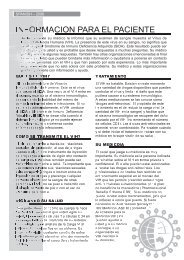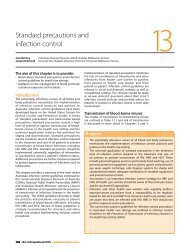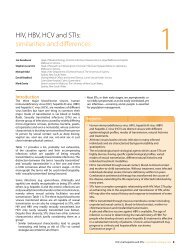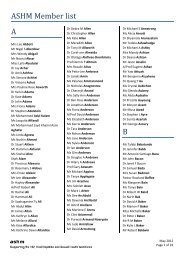B Positive – all you wanted to know about - ASHM
B Positive – all you wanted to know about - ASHM
B Positive – all you wanted to know about - ASHM
You also want an ePaper? Increase the reach of your titles
YUMPU automatically turns print PDFs into web optimized ePapers that Google loves.
of Hbeag, however, does not necessarily<br />
preclude active viral replication, since specific<br />
mutations in the HbV genome can prevent<br />
Hbeag synthesis—so-c<strong>all</strong>ed precore and core<br />
promoter mutants. Patients with these HbV<br />
mutants have elevated HbV dna and aLt levels,<br />
despite the absence of Hbeag (Hbeag-negative<br />
cHb). the frequency of Hbeag-negative cHb<br />
is increasing, representing 20<strong>–</strong>40% of cHb<br />
infection in australia. 2,3<br />
HbV dna is a measure of viral replication, often<br />
used as a criterion for commencing antiviral<br />
therapy in patients with cHb. furthermore, in<br />
population studies, a HbV dna level greater<br />
than 2000 iu/mL is found <strong>to</strong> be a strong<br />
predic<strong>to</strong>r of increased risk for cirrhosis and Hcc. 4<br />
Levels of HbV dna were previously expressed<br />
as copies/mL, but these should be converted<br />
<strong>to</strong> the accepted standard of international<br />
units (iu)/mL. the conversion fac<strong>to</strong>r is<br />
1 iu/mL = 5<strong>–</strong>6 copies/mL (the range from<br />
5.2<strong>–</strong>5.8 depends on the labora<strong>to</strong>ry). currently,<br />
most HbV dna assays are based on realtime<br />
polymerase chain reaction (Pcr),<br />
which provides increased sensitivity and<br />
greater dynamic range quantification than<br />
hybridisation assays. an earlier version of a<br />
hybridisation assay, used commonly until a<br />
few years ago, had a threshold of detection<br />
greater than 20,000 iu/mL (>141,500 copies/<br />
mL). Hence the clinical status for some patients<br />
may need <strong>to</strong> be reinterpreted with results<br />
from newer assays. in particular, patients with<br />
Hbeag-negative cHb might be erroneously<br />
diagnosed as in the immune control phase, due<br />
<strong>to</strong> the inability of older assays <strong>to</strong> demonstrate<br />
viraemia below the level of the assay detection<br />
threshold. 2<br />
the threshold of HbV dna level associated with<br />
liver disease is un<strong>know</strong>n. However, treatment is<br />
usu<strong>all</strong>y considered in Hbeag-positive patients<br />
with HbV dna level ≥ 20,000 iu/mL, and in<br />
Hbeag-negative patients with HbV dna ≥ 2000<br />
iu/mL. 1<br />
HbV dna levels may fluctuate widely in<br />
cHb, so a more accurate assessment of the<br />
patient’s clinical status requires serial HbV dna<br />
measurements over time.<br />
Labora<strong>to</strong>ry evaluation should also include an<br />
assessment of liver enzymes, hepatic synthetic<br />
function (including coagulation profile), as<br />
well as liver ultrasound and alpha fe<strong>to</strong>protein<br />
estimation. a complete labora<strong>to</strong>ry screen for<br />
other causes of liver dysfunction and testing<br />
for co-infection with other viruses (hepatitis c<br />
and d) is recommended. 1<br />
Liver biopsy should be only performed on the<br />
recommendation of a specialist clinician. Liver<br />
biopsy provides an accurate assessment of<br />
the degree of necroinflamma<strong>to</strong>ry activity and<br />
the extent of hepatic fibrosis, as well as the<br />
exclusion of other liver diseases. such results<br />
can be vital in informing the need for antiviral<br />
therapy. However, some patients resist liver<br />
biopsy because of its invasive nature and risk<br />
of complications, such as haemorrhage and<br />
g<strong>all</strong> bladder perforation. further research in<strong>to</strong><br />
non-invasive assessment of hepatic fibrosis<br />
is required (see chapter 3: Hepatitis b virus<br />
testing and interpreting test results).<br />
Acute HBV infection<br />
the incidence of acute HbV infection has been<br />
decreasing in Western countries for a number of<br />
years, probably due <strong>to</strong> widespread vaccination.<br />
acute HbV infection is characterised by the<br />
onset of symp<strong>to</strong>ms 1<strong>–</strong>4 months after exposure.<br />
a serum sickness-like syndrome may occur,<br />
followed by an illness characterised by<br />
symp<strong>to</strong>ms of anorexia, nausea, jaundice, and<br />
right upper quadrant pain. symp<strong>to</strong>ms usu<strong>all</strong>y<br />
disappear after 1<strong>–</strong>3 months, but some patients<br />
have prolonged fatigue even after the liver<br />
function tests have normalised.<br />
elevated alanine and aspartate<br />
aminotransferase (aLt/ast) with values up<br />
<strong>to</strong> 1000<strong>–</strong>2000 iu/L are characteristic of acute<br />
HbV. Prothrombin time is the best guide <strong>to</strong><br />
prognosis. in the early phase of infection,<br />
Hbsag, anti-Hbc igM and Hbeag are <strong>all</strong> positive.<br />
the disappearance of Hbsag is usu<strong>all</strong>y followed<br />
by the appearance of anti-Hbs. However, the<br />
appearance of this antibody may be delayed,<br />
thus creating a window period where the<br />
diagnosis of recent HbV infection can only be<br />
made by the detection of anti-Hbc igM.<br />
b <strong>Positive</strong> <strong>–</strong> <strong>all</strong> <strong>you</strong> <strong>wanted</strong> <strong>to</strong> <strong>know</strong> <strong>about</strong> hepatitis b: a guide for primary care providers 53






